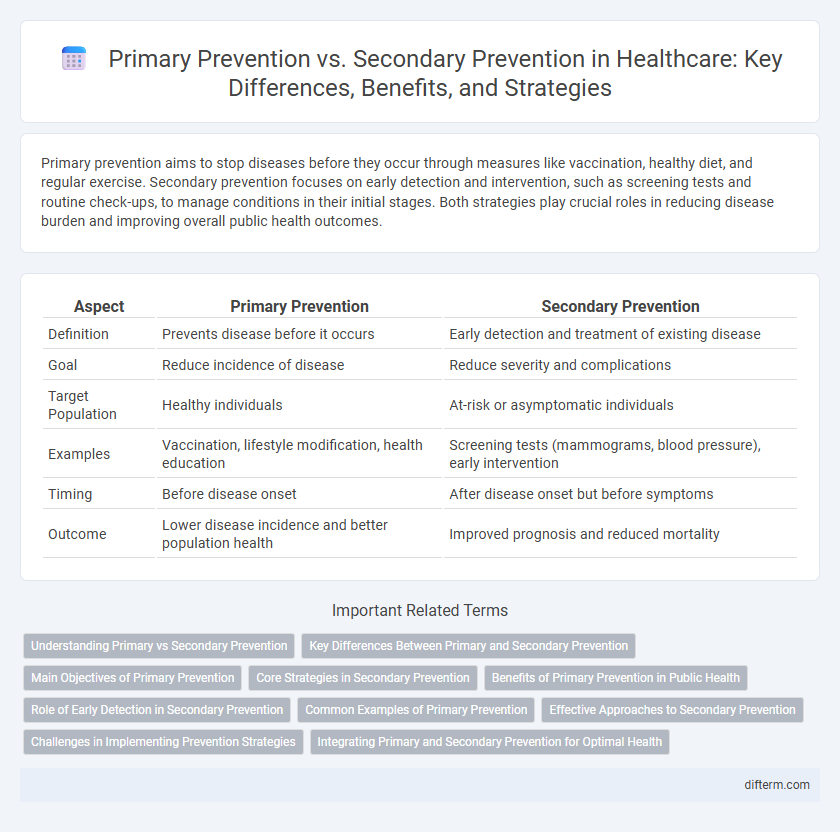Primary prevention aims to stop diseases before they occur through measures like vaccination, healthy diet, and regular exercise. Secondary prevention focuses on early detection and intervention, such as screening tests and routine check-ups, to manage conditions in their initial stages. Both strategies play crucial roles in reducing disease burden and improving overall public health outcomes.
Table of Comparison
| Aspect | Primary Prevention | Secondary Prevention |
|---|---|---|
| Definition | Prevents disease before it occurs | Early detection and treatment of existing disease |
| Goal | Reduce incidence of disease | Reduce severity and complications |
| Target Population | Healthy individuals | At-risk or asymptomatic individuals |
| Examples | Vaccination, lifestyle modification, health education | Screening tests (mammograms, blood pressure), early intervention |
| Timing | Before disease onset | After disease onset but before symptoms |
| Outcome | Lower disease incidence and better population health | Improved prognosis and reduced mortality |
Understanding Primary vs Secondary Prevention
Primary prevention aims to stop the onset of disease by promoting healthy behaviors, vaccinations, and lifestyle modifications. Secondary prevention focuses on early disease detection through screening tests and timely intervention to halt progression. Both approaches are essential for reducing overall disease burden and improving public health outcomes.
Key Differences Between Primary and Secondary Prevention
Primary prevention aims to stop the onset of disease by reducing risk factors through measures like vaccination, healthy diet, and exercise. Secondary prevention focuses on early disease detection using screening tests such as mammograms or blood pressure monitoring to halt progression. The key difference lies in timing: primary prevention occurs before any signs of illness, while secondary prevention targets asymptomatic individuals to identify disease early.
Main Objectives of Primary Prevention
Primary prevention aims to reduce the incidence of disease by promoting healthy behaviors and eliminating risk factors before the onset of illness. Key objectives include vaccination, health education, lifestyle modification, and environmental safety to prevent diseases such as cardiovascular conditions, diabetes, and infectious diseases. Implementing these strategies effectively decreases the population's vulnerability and enhances overall public health outcomes.
Core Strategies in Secondary Prevention
Secondary prevention focuses on early detection and intervention to halt disease progression through strategies such as regular screenings, diagnostic tests, and prompt treatment of preclinical conditions. Core strategies include targeted screenings like mammograms for breast cancer, blood pressure monitoring for hypertension, and cholesterol testing to prevent cardiovascular diseases. These measures aim to identify risk factors or asymptomatic diseases, enabling timely medical response and reducing morbidity and mortality rates.
Benefits of Primary Prevention in Public Health
Primary prevention in public health focuses on reducing the incidence of diseases by addressing risk factors before the onset of illness through interventions such as vaccinations, health education, and lifestyle modifications. This approach decreases healthcare costs and enhances population health by preventing chronic conditions like diabetes, cardiovascular diseases, and infectious diseases. Early investment in primary prevention leads to improved quality of life, reduced morbidity and mortality rates, and alleviates the burden on healthcare systems.
Role of Early Detection in Secondary Prevention
Early detection plays a critical role in secondary prevention by identifying diseases at an asymptomatic or early stage, allowing timely intervention to halt progression and reduce complications. Screening programs, such as mammograms for breast cancer and blood pressure monitoring for hypertension, enable health professionals to catch conditions before they cause significant harm. Effective secondary prevention strategies significantly improve patient outcomes and reduce healthcare costs by minimizing the need for advanced treatments.
Common Examples of Primary Prevention
Primary prevention focuses on measures to prevent the onset of disease before it occurs, such as immunizations, health education, and lifestyle modifications like regular exercise and balanced nutrition. Vaccination programs targeting infectious diseases like influenza and measles serve as crucial examples, reducing incidence rates and protecting public health. Promoting tobacco cessation and encouraging routine screenings for risk factors like hypertension and obesity also exemplify primary prevention strategies that minimize future health complications.
Effective Approaches to Secondary Prevention
Effective approaches to secondary prevention include regular screening tests, early diagnosis, and prompt management of diseases to halt progression and reduce complications. Targeted interventions such as lifestyle modifications, medication adherence, and patient education are essential to improve health outcomes and prevent relapse. Implementing systematic follow-up and risk factor monitoring further enhances the success of secondary prevention strategies in chronic disease management.
Challenges in Implementing Prevention Strategies
Primary prevention faces challenges such as limited public awareness, behavioral change difficulty, and resource constraints for widespread vaccination and lifestyle interventions. Secondary prevention struggles with early detection barriers, including inadequate screening programs, limited access to healthcare, and patient adherence issues. Both prevention strategies require tailored communication, sustained funding, and integrated healthcare systems to overcome implementation obstacles effectively.
Integrating Primary and Secondary Prevention for Optimal Health
Integrating primary and secondary prevention strategies enhances overall health outcomes by addressing risk factors before disease onset and detecting conditions early for timely intervention. Effective coordination between vaccination programs, lifestyle modifications, and regular screening tests allows healthcare providers to reduce disease incidence and progression simultaneously. This combined approach maximizes resource utilization and promotes sustained health improvements across populations.
Primary Prevention vs Secondary Prevention Infographic

 difterm.com
difterm.com